Instrument Performance Analysis for Methane Point Source Retrieval and Estimation Using Remote Sensing Technique
Abstract
1. Introduction
2. Materials and Methods
2.1. WRF-LES and Radiance Simulation
2.2. IMAP-DOAS Retrieval
2.3. Methods for Quantifying Point Source Emission Rates
2.4. Settings for Instrument Response Functions and SNR
2.5. The Degradation of Spatial Resolution
3. Results
3.1. Performance of Different Spectral Resolutions
3.2. Performance of Different Spatial Resolutions
3.3. Performance of Different SNRs
3.4. The Coupled Effect of Key Parameters on Methane Plume Retrieval
4. Discussion
5. Conclusions
Supplementary Materials
Author Contributions
Funding
Data Availability Statement
Conflicts of Interest
Abbreviations
| AHSI | Advanced hyperspectral imager |
| AMF | Air mass factor |
| CN | Constant noise |
| EDF | Environmental Defense Fund |
| EMIT | Earth surface mineral dust source investigation |
| EnMAP | Environmental mapping and analysis program |
| FWHM | Full width at half maximum |
| GHGSat | Greenhouse gas satellite |
| GOSAT | Greenhouse Gases Observing Satellite |
| IMAP-DOAS | Iterative maximum a posteriori–differential optical absorption spectroscopy |
| IME | Integrated mass enhancement |
| MAE | The mean absolute error |
| PN | Photon noise |
| PRISMA | Hyperspectral precursor of the application mission |
| R2 | Correlation coefficient |
| RMSE | Root mean square error |
| SNR | Signal-to-noise ratio |
| SRF | Spectral response function |
| SZA | Solar zenith angle |
| TOA | Top-of-atmosphere |
| TROPOMI | Tropospheric monitoring instrument |
| WRF-LES | Weather Research and Forecasting Large Eddy Simulation |
| XCH4 | Column-averaged methane dry air mole fraction |
References
- Naik, V.; Szopa, S.; Adhikary, B.; Artaxo, P.; Berntsen, T.; Collins, W.D.; Fuzzi, S.; Gallardo, L.; Kiendler Scharr, A.; Klimont, Z.; et al. Short-Lived Climate Forcers. In Climate Change 2021: The Physical Science Basis. Contribution of Working Group I to the Sixth Assessment Report of the Intergovernmental Panel on Climate Change; Masson-Delmotte, V., Zhai, P., Pirani, A., Connors, S.L., Peán, C., Berger, S., Caud, N., Chen, Y., Goldfarb, L., Gomis, M.L., Eds.; Cambridge University Press: Cambridge, UK, 2021; pp. 817–921. [Google Scholar]
- Saunois, M.; Stavert, A.R.; Poulter, B.; Bousquet, P.; Canadell, J.G.; Jackson, R.B.; Raymond, P.A.; Dlugokencky, E.J.; Houweling, S.; Patra, P.K.; et al. The Global Methane Budget 2000–2017. Earth Syst. Sci. Data 2020, 12, 1561–1623. [Google Scholar] [CrossRef]
- Duren, R.M.; Thorpe, A.K.; Foster, K.T.; Rafiq, T.; Hopkins, F.M.; Yadav, V.; Bue, B.D.; Thompson, D.R.; Conley, S.; Colombi, N.K.; et al. California’s Methane Super-Emitters. Nature 2019, 575, 180–184. [Google Scholar] [CrossRef]
- Brandt, A.R.; Heath, G.A.; Cooley, D. Methane Leaks from Natural Gas Systems Follow Extreme Distributions. Environ. Sci. Technol. 2016, 50, 12512–12520. [Google Scholar] [CrossRef]
- Erland, B.M.; Thorpe, A.K.; Gamon, J.A. Recent Advances Toward Transparent Methane Emissions Monitoring: A Review. Environ. Sci. Technol. 2022, 56, 16567–16581. [Google Scholar] [CrossRef] [PubMed]
- Jacob, D.J.; Varon, D.J.; Cusworth, D.H.; Dennison, P.E.; Frankenberg, C.; Gautam, R.; Guanter, L.; Kelley, J.; McKeever, J.; Ott, L.E.; et al. Quantifying Methane Emissions from the Global Scale down to Point Sources Using Satellite Observations of Atmospheric Methane. Atmos. Chem. Phys. 2022, 22, 9617–9646. [Google Scholar] [CrossRef]
- Yoshida, Y.; Ota, Y.; Eguchi, N.; Kikuchi, N.; Nobuta, K.; Tran, H.; Morino, I.; Yokota, T. Retrieval Algorithm for CO2 and CH4 Column Abundances from Short-Wavelength Infrared Spectral Observations by the Greenhouse Gases Observing Satellite. Atmos. Meas. Tech. 2011, 4, 717–734. [Google Scholar] [CrossRef]
- Schepers, D.; Guerlet, S.; Butz, A.; Landgraf, J.; Frankenberg, C.; Hasekamp, O.; Blavier, J.-F.; Deutscher, N.M.; Griffith, D.W.T.; Hase, F.; et al. Methane Retrievals from Greenhouse Gases Observing Satellite (GOSAT) Shortwave Infrared Measurements: Performance Comparison of Proxy and Physics Retrieval Algorithms. J. Geophys. Res. Atmos. 2012, 117. [Google Scholar] [CrossRef]
- Hu, H.; Hasekamp, O.; Butz, A.; Galli, A.; Landgraf, J.; Aan de Brugh, J.; Borsdorff, T.; Scheepmaker, R.; Aben, I. The Operational Methane Retrieval Algorithm for TROPOMI. Atmos. Meas. Tech. 2016, 9, 5423–5440. [Google Scholar] [CrossRef]
- Qu, Z.; Jacob, D.J.; Shen, L.; Lu, X.; Zhang, Y.; Scarpelli, T.R.; Nesser, H.; Sulprizio, M.P.; Maasakkers, J.D.; Bloom, A.A.; et al. Global Distribution of Methane Emissions: A Comparative Inverse Analysis of Observations from the TROPOMI and GOSAT Satellite Instruments. Atmos. Chem. Phys. 2021, 21, 14159–14175. [Google Scholar] [CrossRef]
- Guanter, L.; Irakulis-Loitxate, I.; Gorroño, J.; Sánchez-García, E.; Cusworth, D.H.; Varon, D.J.; Cogliati, S.; Colombo, R. Mapping Methane Point Emissions with the PRISMA Spaceborne Imaging Spectrometer. Remote Sens. Environ. 2021, 265, 112671. [Google Scholar] [CrossRef]
- Storch, T.; Honold, H.-P.; Chabrillat, S.; Habermeyer, M.; Tucker, P.; Brell, M.; Ohndorf, A.; Wirth, K.; Betz, M.; Kuchler, M.; et al. The EnMAP Imaging Spectroscopy Mission towards Operations. Remote Sens. Environ. 2023, 294, 113632. [Google Scholar] [CrossRef]
- Siddiqui, A.; Halder, S.; Kannemadugu, H.B.S.; Prakriti; Chauhan, P. Detecting Methane Emissions from Space in India: Analysis Using EMIT and Sentinel-5P TROPOMI Datasets. J. Indian Soc. Remote Sens. 2024, 52, 1901–1921. [Google Scholar] [CrossRef]
- He, Z.; Gao, L.; Liang, M.; Zeng, Z.-C. A Survey of Methane Point Source Emissions from Coal Mines in Shanxi Province of China Using AHSI on Board Gaofen-5B. Atmos. Meas. Tech. 2024, 17, 2937–2956. [Google Scholar] [CrossRef]
- Jervis, D.; McKeever, J.; Durak, B.O.A.; Sloan, J.J.; Gains, D.; Varon, D.J.; Ramier, A.; Strupler, M.; Tarrant, E. The GHGSat-D Imaging Spectrometer. Atmos. Meas. Tech. 2021, 14, 2127–2140. [Google Scholar] [CrossRef]
- Chan Miller, C.; Roche, S.; Wilzewski, J.S.; Liu, X.; Chance, K.; Souri, A.H.; Conway, E.; Luo, B.; Samra, J.; Hawthorne, J.; et al. Methane Retrieval from MethaneAIR Using the CO2 Proxy Approach: A Demonstration for the Upcoming MethaneSAT Mission. Atmos. Meas. Tech. 2024, 17, 5429–5454. [Google Scholar] [CrossRef]
- Irakulis-Loitxate, I.; Guanter, L.; Liu, Y.-N.; Varon, D.J.; Maasakkers, J.D.; Zhang, Y.; Chulakadabba, A.; Wofsy, S.C.; Thorpe, A.K.; Duren, R.M.; et al. Satellite-Based Survey of Extreme Methane Emissions in the Permian Basin. Sci. Adv. 2021, 7, eabf4507. [Google Scholar] [CrossRef]
- Irakulis-Loitxate, I.; Guanter, L.; Maasakkers, J.D.; Zavala-Araiza, D.; Aben, I. Satellites Detect Abatable Super-Emissions in One of the World’s Largest Methane Hotspot Regions. Environ. Sci. Technol. 2022, 56, 2143–2152. [Google Scholar] [CrossRef] [PubMed]
- Sherwin, E.D.; Rutherford, J.S.; Chen, Y.; Aminfard, S.; Kort, E.A.; Jackson, R.B.; Brandt, A.R. Single-Blind Validation of Space-Based Point-Source Detection and Quantification of Onshore Methane Emissions. Sci. Rep. 2023, 13, 3836. [Google Scholar] [CrossRef]
- MacLean, J.-P.W.; Girard, M.; Jervis, D.; Marshall, D.; McKeever, J.; Ramier, A.; Strupler, M.; Tarrant, E.; Young, D. Offshore Methane Detection and Quantification from Space Using Sun Glint Measurements with the GHGSat Constellation. Atmos. Meas. Tech. 2024, 17, 863–874. [Google Scholar] [CrossRef]
- Roger, J.; Irakulis-Loitxate, I.; Valverde, A.; Gorroño, J.; Chabrillat, S.; Brell, M.; Guanter, L. High-Resolution Methane Mapping with the EnMAP Satellite Imaging Spectroscopy Mission. IEEE Trans. Geosci. Remote Sens. 2023, 62, 1–12. [Google Scholar] [CrossRef]
- Han, G.; Pei, Z.; Shi, T.; Mao, H.; Li, S.; Mao, F.; Ma, X.; Zhang, X.; Gong, W. Unveiling Unprecedented Methane Hotspots in China’s Leading Coal Production Hub: A Satellite Mapping Revelation. Geophys. Res. Lett. 2024, 51, e2024GL109065. [Google Scholar] [CrossRef]
- Thorpe, A.K.; Green, R.O.; Thompson, D.R.; Brodrick, P.G.; Chapman, J.W.; Elder, C.D.; Irakulis-Loitxate, I.; Cusworth, D.H.; Ayasse, A.K.; Duren, R.M.; et al. Attribution of Individual Methane and Carbon Dioxide Emission Sources Using EMIT Observations from Space. Sci. Adv. 2023, 9, eadh2391. [Google Scholar] [CrossRef]
- Kruse, F. The Effects of Spatial Resolution, Spectral Resolution, and SNR on Geologic. In Proceedings of the 9th JPL Airborne Earth Science Workshop, Monterey, CA, USA, 27 February–2 March 2001. [Google Scholar]
- Cusworth, D.H.; Jacob, D.J.; Varon, D.J.; Chan Miller, C.; Liu, X.; Chance, K.; Thorpe, A.K.; Duren, R.M.; Miller, C.E.; Thompson, D.R.; et al. Potential of Next-Generation Imaging Spectrometers to Detect and Quantify Methane Point Sources from Space. Atmos. Meas. Tech. 2019, 12, 5655–5668. [Google Scholar] [CrossRef]
- Ayasse, A.K.; Dennison, P.E.; Foote, M.; Thorpe, A.K.; Joshi, S.; Green, R.O.; Duren, R.M.; Thompson, D.R.; Roberts, D.A. Methane Mapping with Future Satellite Imaging Spectrometers. Remote Sens. 2019, 11, 3054. [Google Scholar] [CrossRef]
- Jongaramrungruang, S.; Matheou, G.; Thorpe, A.K.; Zeng, Z.-C.; Frankenberg, C. Remote Sensing of Methane Plumes: Instrument Tradeoff Analysis for Detecting and Quantifying Local Sources at Global Scale. Atmos. Meas. Tech. 2021, 14, 7999–8017. [Google Scholar] [CrossRef]
- Scafutto, R.D.M.; Van Der Werff, H.; Bakker, W.H.; Van Der Meer, F.; Souza Filho, C.R.D. An Evaluation of Airborne SWIR Imaging Spectrometers for CH4 Mapping: Implications of Band Positioning, Spectral Sampling and Noise. Int. J. Appl. Earth Obs. Geoinf. 2021, 94, 102233. [Google Scholar] [CrossRef]
- Bhimireddy, S.R.; Bhaganagar, K. Implementing a New Formulation in WRF-LES for Buoyant Plume Simulations: bPlume-WRF-LES Model. Mon. Weather Rev. 2021, 149, 2299–2319. [Google Scholar] [CrossRef]
- Varon, D.J.; Jacob, D.J.; McKeever, J.; Jervis, D.; Durak, B.O.A.; Xia, Y.; Huang, Y. Quantifying Methane Point Sources from Fine-Scale Satellite Observations of Atmospheric Methane Plumes. Atmos. Meas. Tech. 2018, 11, 5673–5686. [Google Scholar] [CrossRef]
- Mei, L.; Rozanov, V.; Rozanov, A.; Burrows, J.P. SCIATRAN Software Package (V4.6): Update and Further Development of Aerosol, Clouds, Surface Reflectance Databases and Models. Geosci. Model Dev. 2023, 16, 1511–1536. [Google Scholar] [CrossRef]
- Ayasse, A.K.; Cusworth, D.; O’Neill, K.; Fisk, J.; Thorpe, A.K.; Duren, R. Performance and Sensitivity of Column-Wise and Pixel-Wise Methane Retrievals for Imaging Spectrometers. Atmos. Meas. Tech. 2023, 16, 6065–6074. [Google Scholar] [CrossRef]
- Huang, Y.; Natraj, V.; Zeng, Z.-C.; Kopparla, P.; Yung, Y.L. Quantifying the Impact of Aerosol Scattering on the Retrieval of Methane from Airborne Remote Sensing Measurements. Atmos. Meas. Tech. 2020, 13, 6755–6769. [Google Scholar] [CrossRef]
- Frankenberg, C.; Platt, U.; Wagner, T. Iterative Maximum a Posteriori (IMAP)-DOAS for Retrieval of Strongly Absorbing Trace Gases: Model Studies for CH4 and CO2 Retrieval from near Infrared Spectra of SCIAMACHY Onboard. Atmos. Chem. Phys. 2005, 5, 9–22. [Google Scholar] [CrossRef]
- He, T.-L.; Boyd, R.J.; Varon, D.J.; Turner, A.J. Increased Methane Emissions from Oil and Gas Following the Soviet Union’s Collapse. Proc. Natl. Acad. Sci. USA 2024, 121, e2314600121. [Google Scholar] [CrossRef]
- Thorpe, A.K.; Frankenberg, C.; Roberts, D.A. Retrieval Techniques for Airborne Imaging of Methane Concentrations Using High Spatial and Moderate Spectral Resolution: Application to AVIRIS. Atmos. Meas. Tech. 2014, 7, 491–506. [Google Scholar] [CrossRef]
- Acito, N.; Diani, M.; Corsini, G. PRISMA Spatial Resolution Enhancement by Fusion with Sentinel-2 Data. IEEE J. Sel. Top. Appl. Earth Obs. Remote Sens. 2022, 15, 62–79. [Google Scholar] [CrossRef]
- Bhardwaj, P.; Kumar, R.; Mitchell, D.A.; Randles, C.A.; Downey, N.; Blewitt, D.; Kosovic, B. Evaluating the Detectability of Methane Point Sources from Satellite Observing Systems Using Microscale Modeling. Sci. Rep. 2022, 12, 17425. [Google Scholar] [CrossRef] [PubMed]
- Sánchez-García, E.; Gorroño, J.; Irakulis-Loitxate, I.; Varon, D.J.; Guanter, L. Mapping Methane Plumes at Very High Spatial Resolution with the WorldView-3 Satellite. Atmos. Meas. Tech. 2022, 15, 1657–1674. [Google Scholar] [CrossRef]
- Nelson, R.R.; Cusworth, D.H.; Thorpe, A.K.; Kim, J.; Elder, C.D.; Nassar, R.; Mastrogiacomo, J.-P. Comparing Point Source CO2 Emission Rate Estimates from Near-Simultaneous OCO-3 and EMIT Observations. Geophys. Res. Lett. 2024, 51, e2024GL113002. [Google Scholar] [CrossRef]
- Ye, B.; Tian, S.; Cheng, Q.; Ge, Y. Application of Lithological Mapping Based on Advanced Hyperspectral Imager (AHSI) Imagery Onboard Gaofen-5 (GF-5) Satellite. Remote Sens. 2020, 12, 3990. [Google Scholar] [CrossRef]
- Cogliati, S.; Sarti, F.; Chiarantini, L.; Cosi, M.; Lorusso, R.; Lopinto, E.; Miglietta, F.; Genesio, L.; Guanter, L.; Damm, A.; et al. The PRISMA Imaging Spectroscopy Mission: Overview and First Performance Analysis. Remote Sens. Environ. 2021, 262, 112499. [Google Scholar] [CrossRef]
- Liu, Y.-N.; Zhang, J.; Zhang, Y.; Sun, W.-W.; Jiao, L.-L.; Sun, D.-X.; Hu, X.-N.; Ye, X.; Li, Y.-D.; Liu, S.-F.; et al. The Advanced Hyperspectral Imager: Aboard China’s GaoFen-5 Satellite. IEEE Geosci. Remote Sens. Mag. 2019, 7, 23–32. [Google Scholar] [CrossRef]
- Thompson, D.R.; Green, R.O.; Bradley, C.; Brodrick, P.G.; Mahowald, N.; Dor, E.B.; Bennett, M.; Bernas, M.; Carmon, N.; Chadwick, K.D.; et al. On-Orbit Calibration and Performance of the EMIT Imaging Spectrometer. Remote Sens. Environ. 2024, 303, 113986. [Google Scholar] [CrossRef]
- Vargas-Rodríguez, E.; Rutt, H.N. Design of CO, CO2 and CH4 Gas Sensors Based on Correlation Spectroscopy Using a Fabry–Perot Interferometer. Sens. Actuators B Chem. 2009, 137, 410–419. [Google Scholar] [CrossRef]
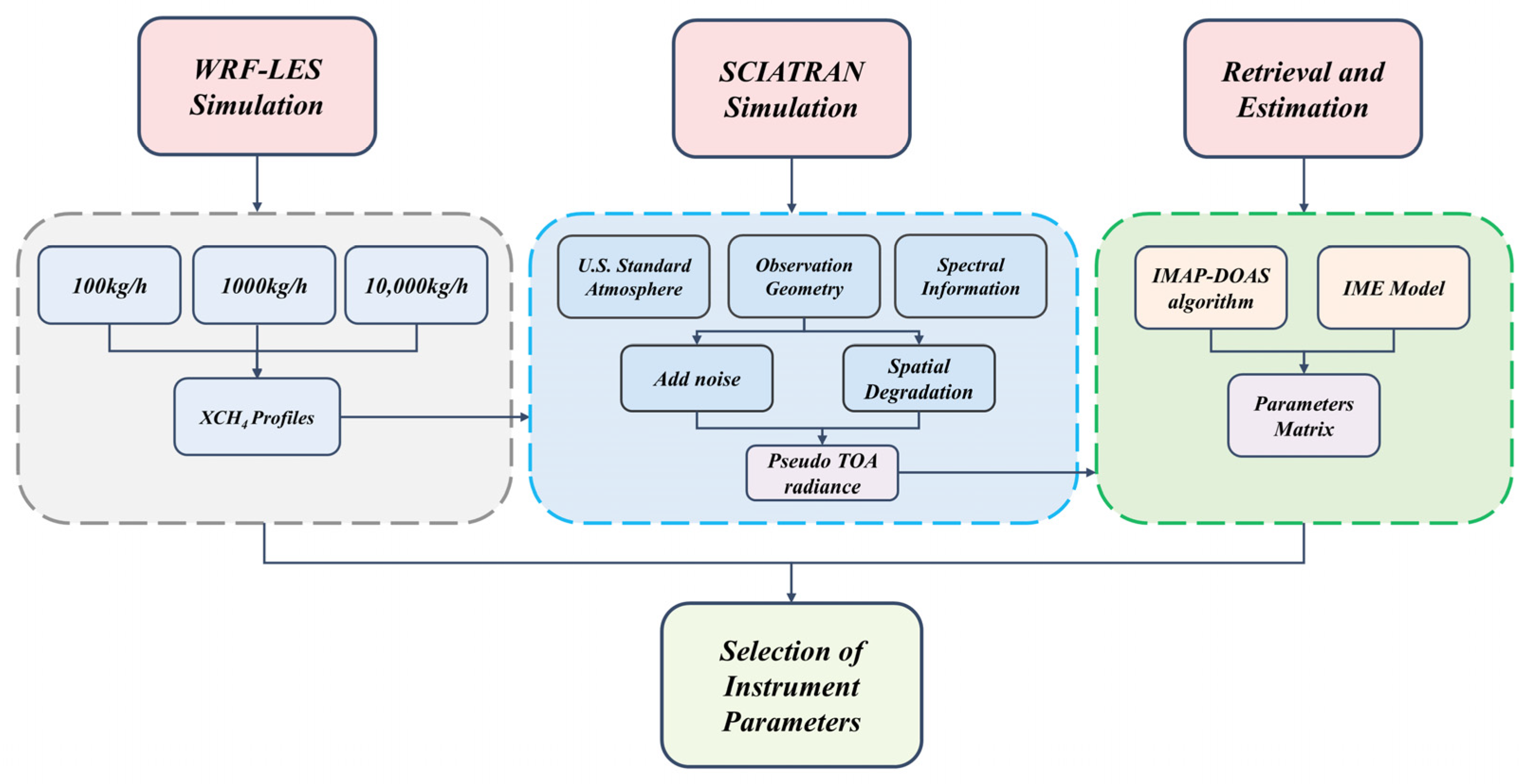

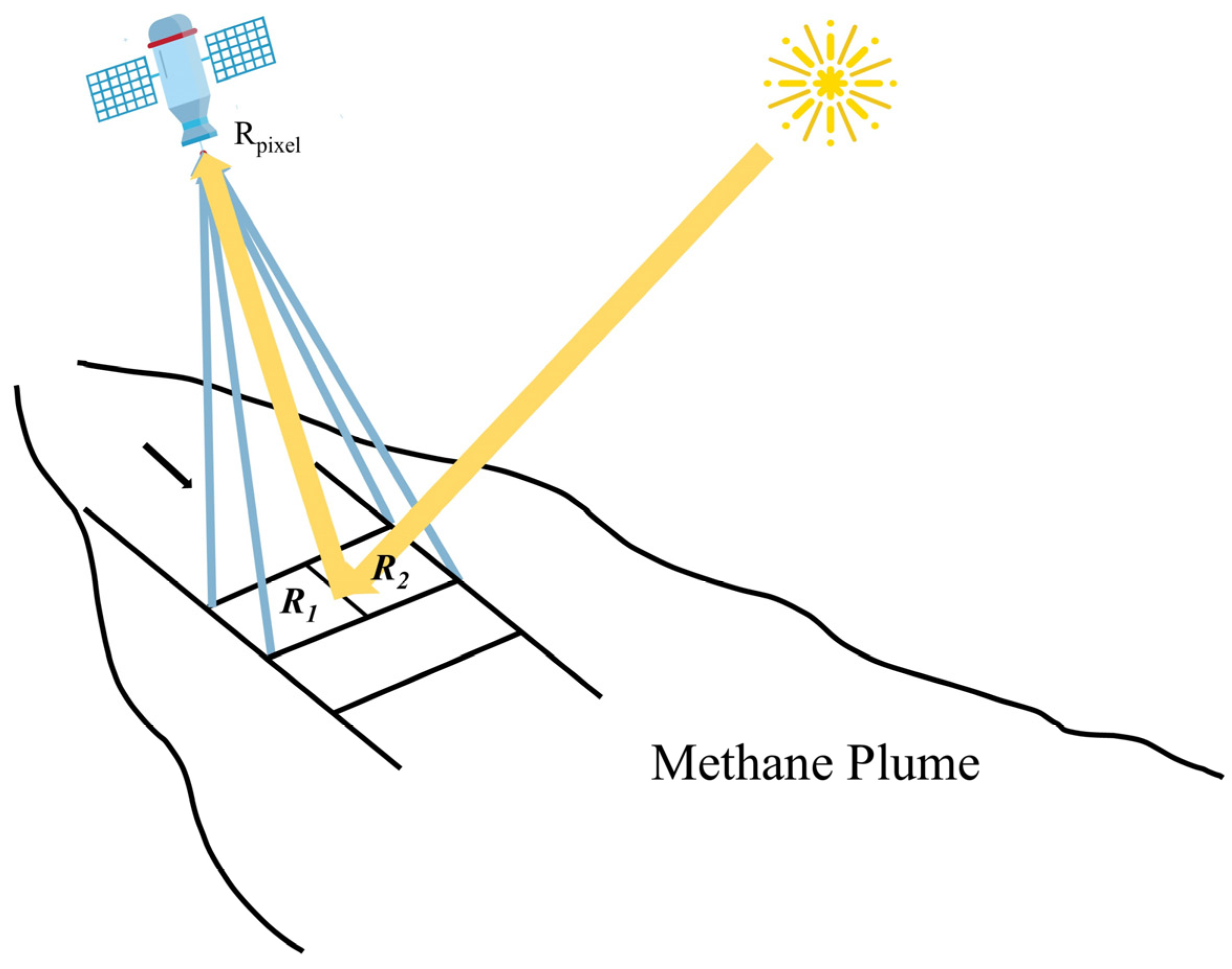
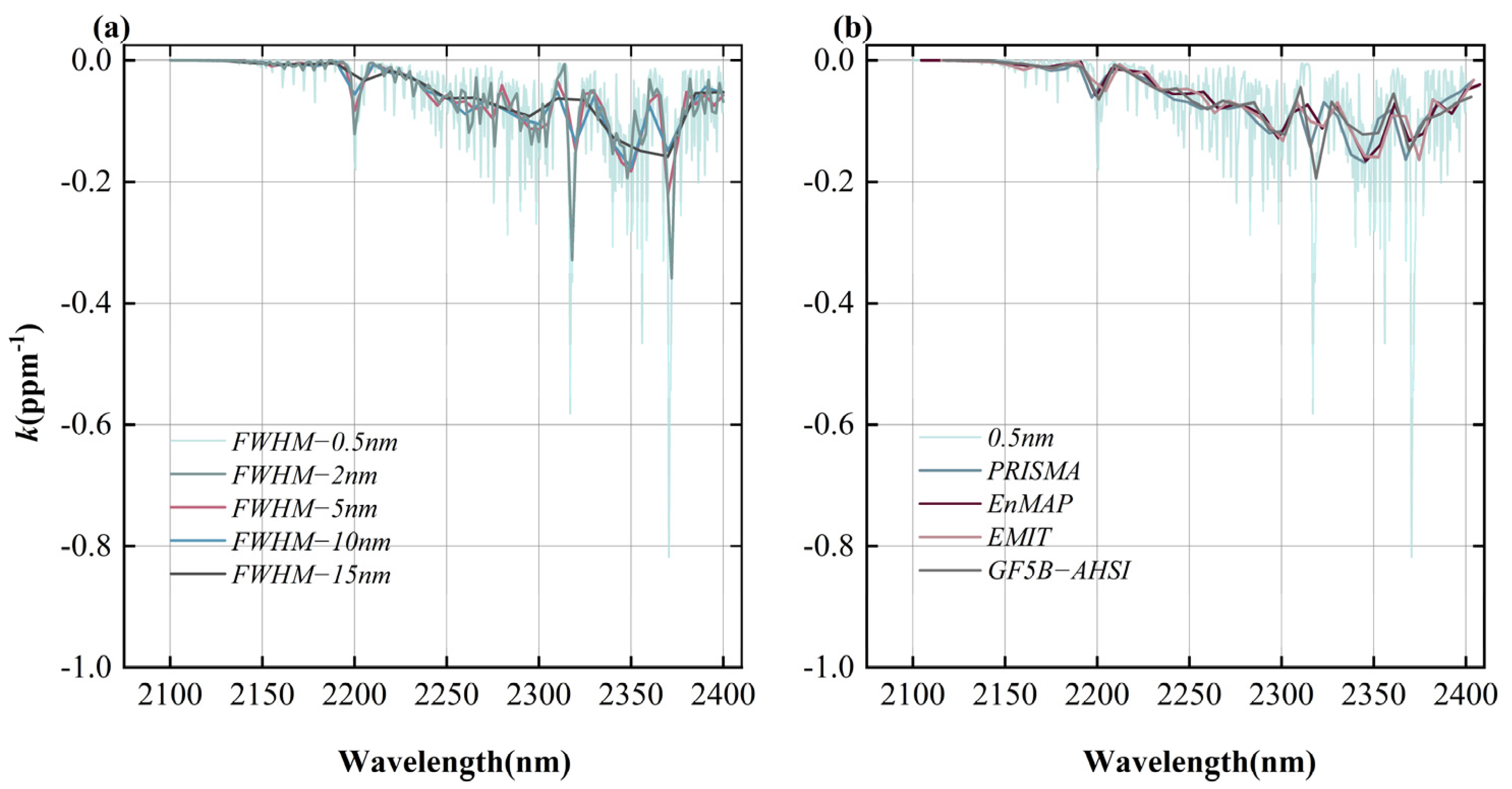

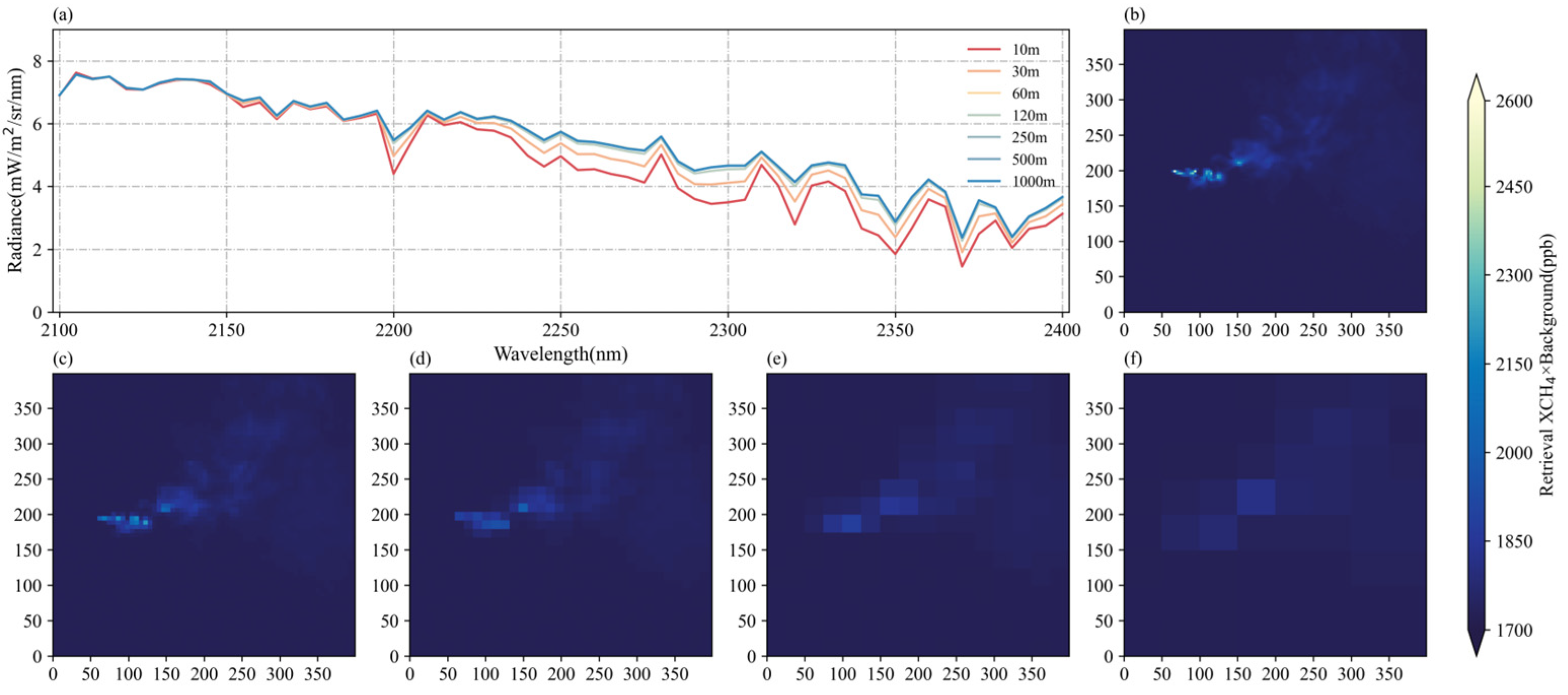
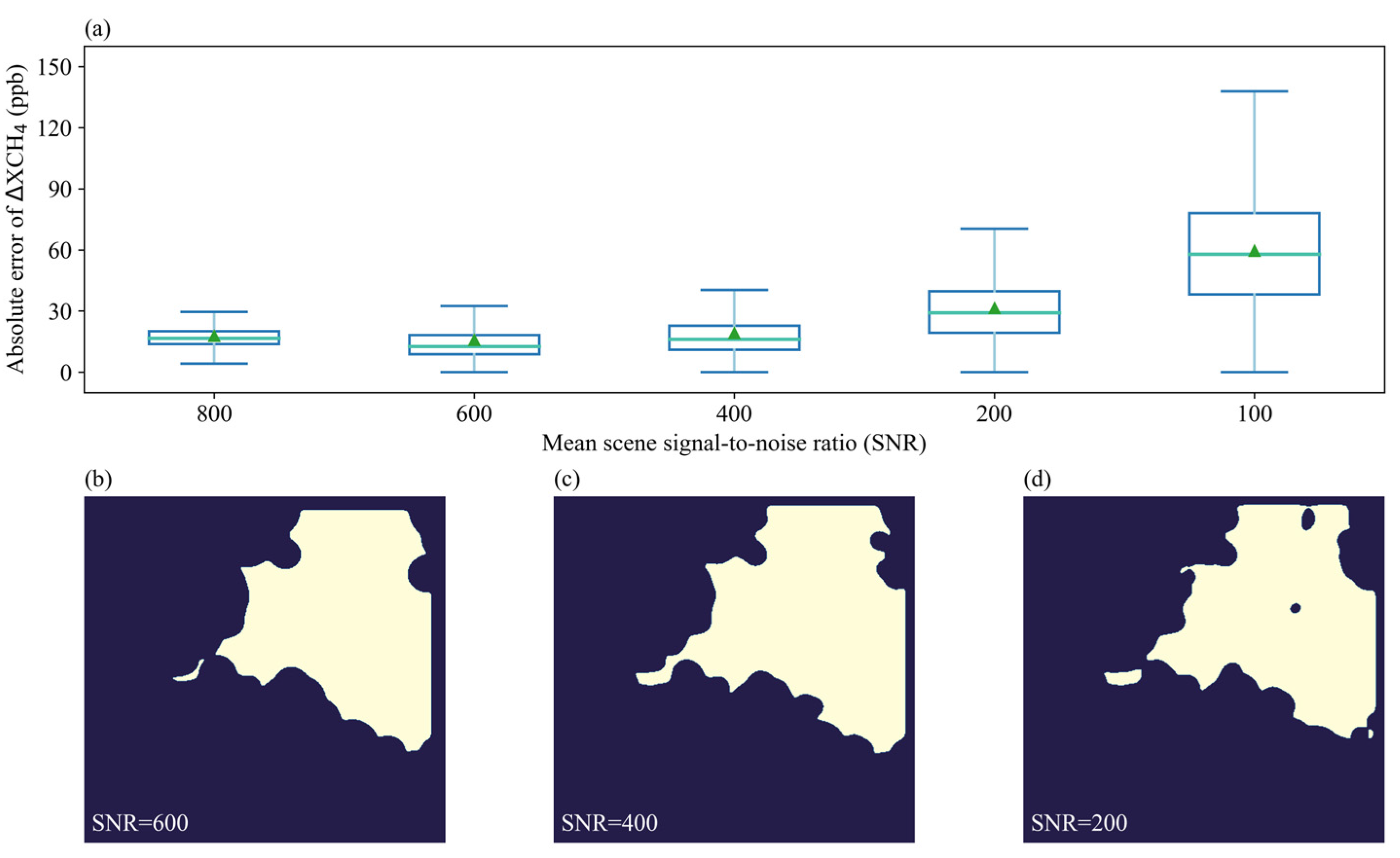

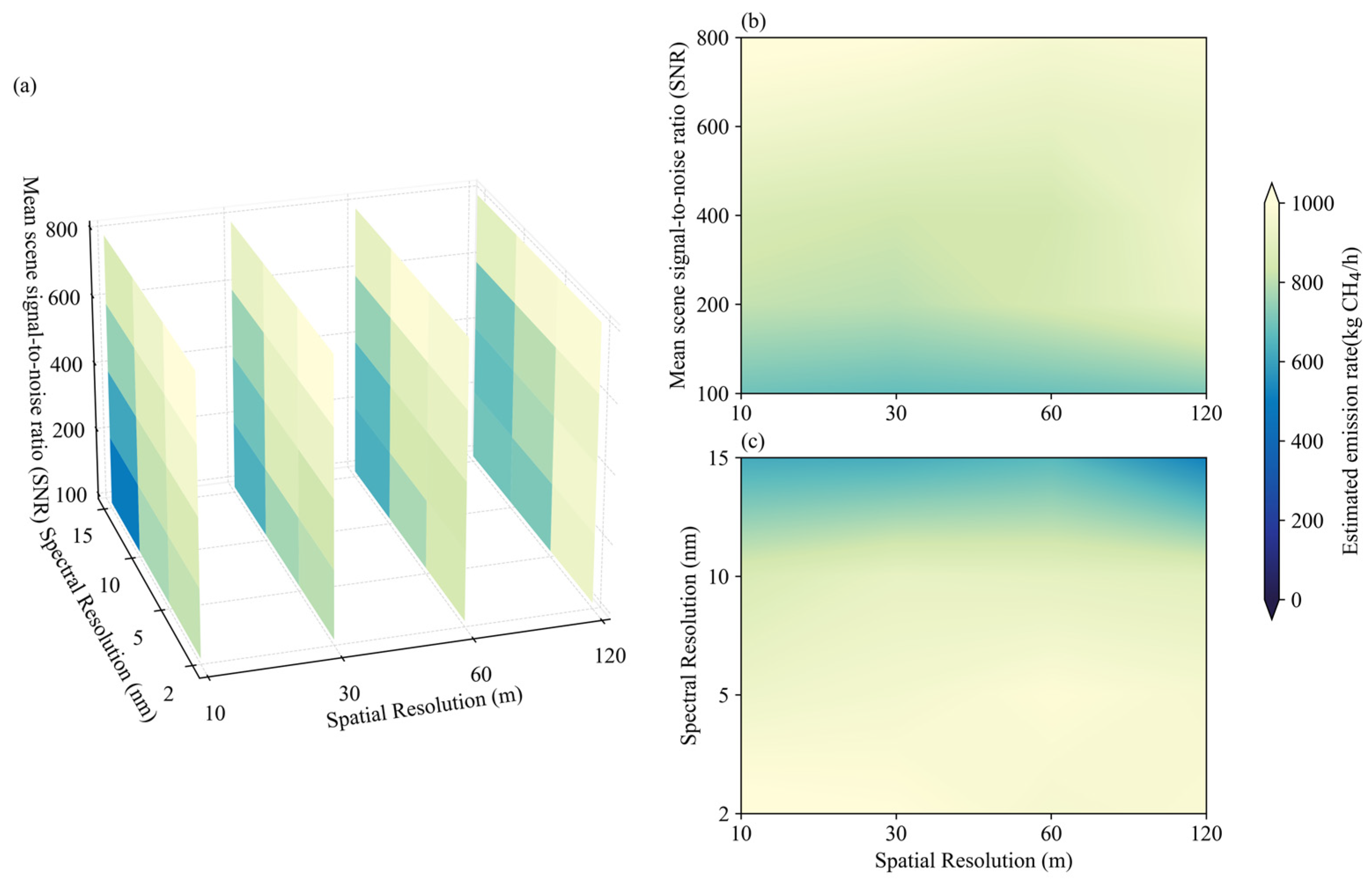
| Satellite | Spatial Resolution | Spectral Resolution (Average FWHM) | SNR | Predicted Emission Rate (kg/h) | Retrieved Emission Rate (kg/h) | Type of Spectrometer | Reference |
|---|---|---|---|---|---|---|---|
| PRISMA | 30 | ~10 | 200 | 639.37 | 644.92 ± 365.99 | Dispersive (prism) | [11] |
| EnMAP | 30 | ~7.8 | 230 | 707.43 | 710.60 ± 403.24 | Dispersive (prism) | [12] |
| EMIT | 60 | ~8.4 | 750 | 894.73 | 899.94 ± 510.92 | Dispersive (grating) | [23] |
| GF5B-AHSI | 30 | 8.25 | 200 | 684.70 | 670.69 ± 380.60 | Dispersive (grating) | [41] |
Disclaimer/Publisher’s Note: The statements, opinions and data contained in all publications are solely those of the individual author(s) and contributor(s) and not of MDPI and/or the editor(s). MDPI and/or the editor(s) disclaim responsibility for any injury to people or property resulting from any ideas, methods, instructions or products referred to in the content. |
© 2025 by the authors. Licensee MDPI, Basel, Switzerland. This article is an open access article distributed under the terms and conditions of the Creative Commons Attribution (CC BY) license (https://creativecommons.org/licenses/by/4.0/).
Share and Cite
Jiang, Y.; Zhang, L.; Zhang, X.; Cao, X.; Dou, H.; Zhang, L.; Yan, H.; Wang, Y.; Si, Y.; Chen, B. Instrument Performance Analysis for Methane Point Source Retrieval and Estimation Using Remote Sensing Technique. Remote Sens. 2025, 17, 634. https://doi.org/10.3390/rs17040634
Jiang Y, Zhang L, Zhang X, Cao X, Dou H, Zhang L, Yan H, Wang Y, Si Y, Chen B. Instrument Performance Analysis for Methane Point Source Retrieval and Estimation Using Remote Sensing Technique. Remote Sensing. 2025; 17(4):634. https://doi.org/10.3390/rs17040634
Chicago/Turabian StyleJiang, Yuhan, Lu Zhang, Xingying Zhang, Xifeng Cao, Haiyang Dou, Lingfeng Zhang, Huanhuan Yan, Yapeng Wang, Yidan Si, and Binglong Chen. 2025. "Instrument Performance Analysis for Methane Point Source Retrieval and Estimation Using Remote Sensing Technique" Remote Sensing 17, no. 4: 634. https://doi.org/10.3390/rs17040634
APA StyleJiang, Y., Zhang, L., Zhang, X., Cao, X., Dou, H., Zhang, L., Yan, H., Wang, Y., Si, Y., & Chen, B. (2025). Instrument Performance Analysis for Methane Point Source Retrieval and Estimation Using Remote Sensing Technique. Remote Sensing, 17(4), 634. https://doi.org/10.3390/rs17040634







